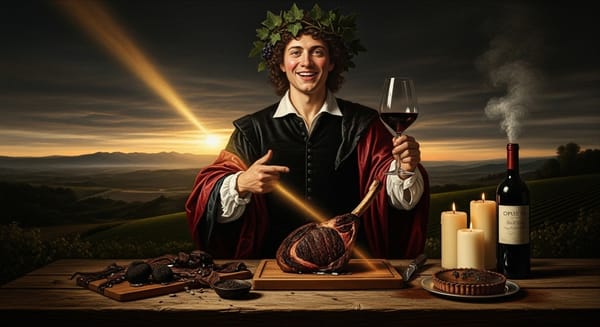Médoc: Left Bank Ambition and Gravel-Born Grace
Dive into the Médoc, Bordeaux’s Left Bank stronghold of Cabernet Sauvignon. Explore its layered terroir, communes like Pauillac and Margaux, and why these wines captivate collectors and investors alike.

Where Gravel Dreams and Tides Decide
The Médoc does not ask to be loved at first sip. It stands by the estuary like a seasoned negotiant counting tides instead of promises, its vineyards threaded with gravel that once slept beneath an inland sea. Ambition here predates leaf and berry. Carriages from Paris once labored north through marsh and mist to taste what drainage, war, and imagination coaxed from reluctant ground. Today, the same determination ripples beneath every ruby surface.
Arrive in pre-dawn half-light and you feel it immediately: a bone-deep hum where wind meets brackish water, a tension between river and Atlantic that emboldens the salt in your lungs. I paused at a weather-worn jetty, the air tannic—cedar-laced, cold as slate—and felt the past lurking like sediment in a decanter. Fishermen mended nets along pilings older than electric light; vineyard dogs barked at the indistinct horizon; somewhere, a single press whistled as grapes met steel. In that hush before sunrise, the Médoc felt less like a region than a pact: endure, and be transfigured.
Marshes, Muskets, and the Rise of Red Ambition
Long before Cabernet Sauvignon found its voice, the Médoc was a sodden spit of land—a hunter’s bog, a refuge for wolves and rumors. Roman troops marched by without interest; medieval monks planted rye and surrendered to mold. Only in the seventeenth century did Dutch engineers arrive with shovels and stubborn faith, carving canals that bled the swamps dry and stacking earthen levees against the capricious Gironde. Gravel beds emerged glinting like armor, and vines responded by sending roots to impossible depths.
The early wines were coarse, sold in casks rather than bottles, prized for resilience on maritime voyages more than finesse. Profit proved an efficient tutor. By the late eighteenth century, brokers in Bordeaux’s Chartrons quarter tasted by candlelight while quills scratched purchase prices against the pungent backdrop of tar and coffee.
Napoleon’s cannons rattled Europe, but the peninsula’s focus remained barrels and markets. When Napoleon III demanded a ranking for the 1855 Exposition Universelle, châteaux lined up like officers: Margaux’s poised elegance, Latour’s iron-backed tenacity, Lafite’s lissome reach toward aristocracy, Mouton’s eventual rebellion. The list never sat still; phylloxera, frost, and recession slashed reputations, then rehabilitation followed as families re-grafted, re-hired, and re-imagined.
The twentieth century brought another reckoning. Stainless steel nudged aside wooden fermenters, temperature control replaced alchemy, helicopters sprayed biodynamic teas where oxen once plowed. Yet the Médoc never shed its memory of marshes; even inside smart-glass laboratories, cellar masters speak of tidal rhythms and lunar phases with the intimacy of folk memory.
Maps Written in Pebble and Pulse
Riverlit Ridges: The Estuary’s Edge
Drive the D2 on an October afternoon and the Gironde looks metallic, reflecting skies that swing from pewter to spear-point silver. Pauillac sits closest, its vines knit tight to the water, gravel mounds shedding heat like slow-beating hearts. Cabernet Sauvignon carves itself here—blackcurrant edged by cedar shavings, the faint bitterness of cigar leaf. Sailors once claimed they smelled fermentation from aboard deck; on certain nights the estuary still carries that bruise-sweet scent downstream.
Southward unfolds Saint-Julien, refinement overlaying iron resolve. Its vineyards appear monk-clipped, yet the wines carry graphite and blackberry that build like a persuasive argument: polite, then undeniable, blooming into leather and sandalwood with age.
Margaux, farther on, feels lighter only at first glance. Fractured gravel mingles with sand; violet and rose lift from the glass, masking a backbone of tannin that can outlive its maker. On warm evenings the château’s neoclassical columns catch dusk like mirrored shards—jasmine resting on a steel blade in youth, dusk lingering on porcelain in maturity.
Pine-Scented Hinterlands: Inland Veins
Turn inland and pine forests temper maritime tantrums. Clay sneaks beneath gravel in Saint-Estèphe; fruit ripens reluctantly, building a bass line of earth and mocha that lingers for decades. The wind smells of iodine and woodsmoke, and the wines echo that austerity.
Listrac and Moulis lie on limestone knolls mottled with quartz. Their wines pulse with cranberry and pomegranate, wrapped in tannin that softens graciously across a decade—margin notes without which the narrative feels incomplete.
Further north, the peninsula narrows toward the Atlantic. Low ridges of gravel interlace with sandy patches where scrub oak and broom thrive. Experimental plots of Touriga Nacional and Castets peek through established rows—insurance against an uncertain climate and an admission that terroir is dialogue, not decree.
Atlantic Bargains and the Price of Heat
The Atlantic is both patron and antagonist. Westerlies ferry salt-sweet breezes that keep mildew in check, only to pivot into storms that flatten trellises overnight. Vintage charts read like diaries of resilience: 1961’s improbable concentration born from June frost; 1982’s generous warmth ushering in modern markets; 2018–2020’s solar crescendos shadowed by drought; 2022’s blistering heat that forced choices between sugar and freshness.
Climate change has sharpened every decision. Some estates harvest earlier to preserve acidity; others delay, chasing phenolic ripeness like the last train home. Frost candles flicker in April rows. Trials with higher vine density shade clusters; reflective mulches spare water. Shade sails of white canvas flutter like gull wings above young parcels, while buried clay amphorae store precious rain. Growers even revive bygone grapes—Castets, Arinarnoa—testing whether forgotten voices might steady the chorus of tomorrow.
Hands That Edit the Vine’s Manuscript
Pruning shears here are quills rewriting winter’s blank manuscript. Old vines—gnarled as veteran sailors—receive no indulgence: an ambitious cane is cut; a fragile spur supported with willow twine. Cover crops of broad beans and vetch carpet certain parcels, luring pollinators and sending roots to fracture compacted earth. Elsewhere, drones hover, mapping chlorophyll stress and guiding irrigation like orchestral conductors.
Summer canopy work resembles tailoring: leaf thinning where mildew lurks, hedging to balance shade and sun, green harvesting that relinquishes quantity so flavor might concentrate. All aims for the brief window when fruit, seed, and skin align in harmonious tension.
When harvest arrives and fog curls between the rows, philosophy melts into instinct. Pickers sort berries by feel—rejecting those that bounce too brightly, coveting skins that whisper resistance. Horse-drawn carts still ferry grapes to small chais; larger estates use vibration tables that thrum like distant bass lines. Fermenting vats flutter with carbonic murmurs, and a sweet haze blankets the courtyard. One careless cluster can dilute an entire cuvée, and everyone knows it.
Voices in a Glass: Cabernet and Its Chorus
Cabernet Sauvignon is the Médoc’s iron-scented spine, but its accent changes by the kilometer. In Pauillac’s deep gravel, skins thicken against river gales, the juice running midnight—graphite, blackcurrant, a dry static crackle that later softens into cigar box and damp forest floor. Margaux’s sand-laced stones coax lilac above cassis, a glissando of acidity that keeps the finish humming; Saint-Estèphe’s clay buries tannins so deep they surface years later as truffle and iron filings.
Merlot plays counterpoint, draping blends in velvet when clay pockets hold the season’s last coolness—plum, fennel, distant hearth smoke. At five to ten years it unbuttons Cabernet’s collar, letting blackberry mingle with damson and cocoa. Petit Verdot, once emergency seasoning, now flashes violet, pepper, and black tea, tightening opulent vintages; some estates even bottle micro-cuvées—a rebellious novella amid epics.
Rare voices—Cabernet Franc’s raspberry leaf and mint, Carmenère’s paprika-tinged mulberry—lift aromatics, proving diversity is ballast, not décor. Experimental blocks of Castets add red-berry nerve for warmer decades ahead.
Ultimately style is forged at the cépage table, where samples gather like negotiators. A Pauillac blend may enter in chain mail and leave in evening dress after a dash of silky Merlot; Margaux writes calligraphy, each grape a precise stroke; Saint-Julien balances Cabernet’s jaw with Merlot’s grin and a raised-eyebrow brush of Petit Verdot. Concrete eggs or amphorae may host the ferment, but the guiding question remains antique: does the wine speak of its gravel, its season, its sleepless harvest nights? When it does, the Médoc has once again turned geology and doubt into something that tastes uncannily like resolve.
Listening Vats and Barrel Ballads
Fermentation rooms feel like listening chambers. Concrete vats hum low, stainless tanks hiss, wooden casks sigh—a choreography of containment. Pump-overs may be gentle, extracting color like tea steeped at dawn, or vigorous, like gymnasts flipping liquid muscle. Some estates trust ambient yeasts; others inoculate for precision.
Malolactic conversations unfold in barrels from forests so specific they might as well be surnames—Allier, Tronçais, Jupilles. New oak is dialogue—toast, smoke, faint sandalwood testing the fruit’s patience. Amphorae and sandstone eggs temper ambition, chasing texture over flavor. One cellar master rolls barrels monthly to awaken lees; another plays Bach fugues at dawn, believing vibrations weave tannins into harmony.
Blending sessions begin in watchful silence, proceeding like negotiations at Versailles—percentages traded, possibilities tasted blind, reputations balanced on the meniscus of a glass. The final cuvée is the moment ink dries on a love letter never sent.
Names Carved into Gravel and Legend
Château Margaux stands like a neoclassical sigh, its wines radiating jasmine and graphite beneath silk-glove tannins. Latour looms nearer the estuary, turreted stone reflecting river-light; its wines stride rather than stroll, patience stitched into every layer. Lafite Rothschild plays chamber music in liquid form—cassis and cedar arranged with mathematical restraint. Cos d’Estournel’s stone elephants guard a courtyard alive with incense notes—spice, cassis, sandal-wooded dusk. Lafon-Rochet, draped in sunflower stucco, marries smoke with violet in Saint-Estèphe’s stern embrace.
Farther north, Château La Tour de By’s lighthouse guides river traffic while vines root into gravel ridges, yielding wines of black tea and blackberry leaves dried in a poetry book—humble yet enduring. Château d’Angludet plows sandy parcels with horses named for constellations, amphorae standing beside barrels like ancient philosophers debating progress. Château d’Arsac hosts contemporary art among Cabernet rows, while Sociando-Mallet turns pauper gravel into Pauillac’s rebellious cousin. Château Chasse-Spleen shrugs ennui with black-cherry exuberance, and Poujeaux in Moulis reminds us that democracy survives amid aristocracy.
The Kiln of Time
Time in the Médoc is less a clock than a kiln. Young Cabernet can be jagged, acids flinting against tannins. Across a decade, angles soften into arches; fruit sinks from cassis to truffle-dusted blackberry; secondary aromas unfurl—cedar chest, saddle leather, autumn hearth smoke. At twenty years, tertiary nuances emerge: graphite turned gunflint, Parma violet threaded through black fruit, the structure now scrolling like parchment. Waiting is not passive but a daily act of trust between cork and curiosity.
Ledgers of Desire
Prices soar because desire is measurable and scarcity seductive, yet to reduce the Médoc to numbers is to audit a cathedral by counting stones. Collectors chase vintages like horologists seeking lost minutes, but the true dividend appears at the table: the hush before pouring, the glint in a friend’s eye, the immediate erosion of doubt as liquid courage meets lived experience. Acquiring Latour futures or cellaring Sociando-Mallet is less about profit than about preserving potential—river fog, August anxiety, December barrel top-ups—until they can be liberated back into memory. Auction houses tally hammer prices with fastidious ledgers, yet the greatest dividend is audible: the soft gasp of a cork surrendering, the ripple of anticipation, the vibrating hush that precedes collective memory taking flight.
When Riverlight Fades, Resolve Remains
Evening in the Médoc feels like standing amid ruins rebuilt ahead of time. Vine leaves rustle with unseen stories, and the Gironde swallows the sun into its pewter depths. These wines are not born to charm; they are raised to endure. Each glass recalls marsh-reclaimed land, oak forests felled for staves, wars survived, fortunes reversed. And yet—there it is—that flicker of exuberance beneath the melancholy: a perfumed exhale of cassis, a hint of rose-scented breeze breaking across graphite stones. In that closing light, the Médoc ceases to be geography and becomes possibility—liquid, unguarded, astonishingly alive. Always remember this.





